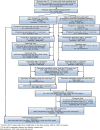Identification of pregnancies and infants within a US commercial healthcare administrative claims database
- PMID: 35622900
- PMCID: PMC9546262
- DOI: 10.1002/pds.5483
Identification of pregnancies and infants within a US commercial healthcare administrative claims database
Abstract
Purpose: Health care insurance claims databases are becoming a more common data source for studies of medication safety during pregnancy. While pregnancies have historically been identified in such databases by pregnancy outcomes, International Classification of Diseases, 10th revision Clinical Modification (ICD-10-CM) Z3A codes denoting weeks of gestation provide more granular information on pregnancies and pregnancy periods (i.e., start and end dates). The purpose of this study was to develop a process that uses Z3A codes to identify pregnancies, pregnancy periods, and links infants within a commercial health insurance claims database.
Methods: We identified pregnancies, gestation periods, pregnancy outcomes, and linked infants within the US-based Optum Research Database between 2015 and 2020 via a series of algorithms utilizing diagnosis and procedure codes on claims. The diagnosis and procedure codes included ICD-10-CM codes, Current Procedural Terminology (CPT) codes, and Healthcare Common Procedure Coding System (HCPCS) codes.
Results: We identified 1 030 874 pregnancies among 841 196 women of reproductive age. Of pregnancies with livebirth outcomes, 84% were successfully linked to infants. The prevalence of pregnancy outcomes (livebirth, stillbirth, ectopic, molar, and abortion) was similar to national estimates.
Conclusions: This process provides an opportunity to study drug safety and care patterns during pregnancy and may be replicated in other claims databases containing ICD-10-CM, CPT, and HCPCS codes. Work is underway to validate and refine the various algorithms.
Keywords: administrative data; claims; infant; last menstrual period; pregnancy.
© 2022 The Authors. Pharmacoepidemiology and Drug Safety published by John Wiley & Sons Ltd.
Figures










Similar articles
-
Development and Validation of ICD-10-CM-based Algorithms for Date of Last Menstrual Period, Pregnancy Outcomes, and Infant Outcomes.Drug Saf. 2023 Feb;46(2):209-222. doi: 10.1007/s40264-022-01261-5. Epub 2023 Jan 19. Drug Saf. 2023. PMID: 36656445 Free PMC article.
-
Identification of pregnancies and their outcomes in healthcare claims data, 2008-2019: An algorithm.PLoS One. 2023 Apr 24;18(4):e0284893. doi: 10.1371/journal.pone.0284893. eCollection 2023. PLoS One. 2023. PMID: 37093890 Free PMC article.
-
Capturing anaphylaxis through medical records: Are ICD and CPT codes sufficient?Ann Allergy Asthma Immunol. 2020 Feb;124(2):150-155. doi: 10.1016/j.anai.2019.11.026. Epub 2019 Nov 27. Ann Allergy Asthma Immunol. 2020. PMID: 31785369 Review.
-
Validation of ICD-9-CM codes to identify gastrointestinal perforation events in administrative claims data among hospitalized rheumatoid arthritis patients.Pharmacoepidemiol Drug Saf. 2011 Nov;20(11):1150-8. doi: 10.1002/pds.2215. Epub 2011 Aug 27. Pharmacoepidemiol Drug Saf. 2011. PMID: 22020901 Free PMC article.
-
Development and Validation of Claims-Based Definitions to Identify Incident and Prevalent Inflammatory Bowel Disease in Administrative Healthcare Databases.Inflamm Bowel Dis. 2023 Dec 5;29(12):1993-1996. doi: 10.1093/ibd/izad053. Inflamm Bowel Dis. 2023. PMID: 37043675 Free PMC article. Review.
Cited by
-
Association of Traditional and Nontraditional Risk Factors in the Development of Strokes Among Young Adults by Sex and Age Group: A Retrospective Case-Control Study.Circ Cardiovasc Qual Outcomes. 2024 Apr;17(4):e010307. doi: 10.1161/CIRCOUTCOMES.123.010307. Epub 2024 Mar 26. Circ Cardiovasc Qual Outcomes. 2024. PMID: 38529631 Free PMC article.
-
Linking household members and defining relational networks using routine health data.Curr Opin Pediatr. 2025 Feb 1;37(1):27-33. doi: 10.1097/MOP.0000000000001415. Epub 2024 Nov 4. Curr Opin Pediatr. 2025. PMID: 39509188 Review.
-
Real-world data are not always big data: the case for primary data collection on medication use in pregnancy in the context of birth defects research.Am J Epidemiol. 2024 Sep 3;193(9):1211-1214. doi: 10.1093/aje/kwae060. Am J Epidemiol. 2024. PMID: 38751306 Free PMC article.
-
Who is pregnant? Defining real-world data-based pregnancy episodes in the National COVID Cohort Collaborative (N3C).JAMIA Open. 2023 Aug 16;6(3):ooad067. doi: 10.1093/jamiaopen/ooad067. eCollection 2023 Oct. JAMIA Open. 2023. PMID: 37600074 Free PMC article.
-
Duration of medication for opioid use disorder during pregnancy and postpartum by race/ethnicity: Results from 6 state Medicaid programs.Drug Alcohol Depend. 2023 Jun 1;247:109868. doi: 10.1016/j.drugalcdep.2023.109868. Epub 2023 Apr 5. Drug Alcohol Depend. 2023. PMID: 37058829 Free PMC article.
References
-
- Cole JA, Ephross SA, Cosmatos IS, Walker AMJP. Safety d. paroxetine in the first trimester and the prevalence of congenital malformations. Pharmacoepidemiol Drug Saf. 2007;16(10):1075‐1085. - PubMed
-
- Cole JA, Modell JG, Haight BR, Cosmatos IS, Stoler JM, Walker AM. Bupropion in pregnancy and the prevalence of congenital malformations. Pharmacoepidemiol Drug Saf. 2007;16(5):474‐484. - PubMed
-
- Carman WJ, Accortt NA, Anthony MS, Iles J, Enger CJP. Safety d. pregnancy and infant outcomes including major congenital malformations among women with chronic inflammatory arthritis or psoriasis, with and without etanercept use. Pharmacoepidemiol Drug Saf. 2017;26(9):1109‐1118. - PubMed
Publication types
MeSH terms
LinkOut - more resources
Full Text Sources

